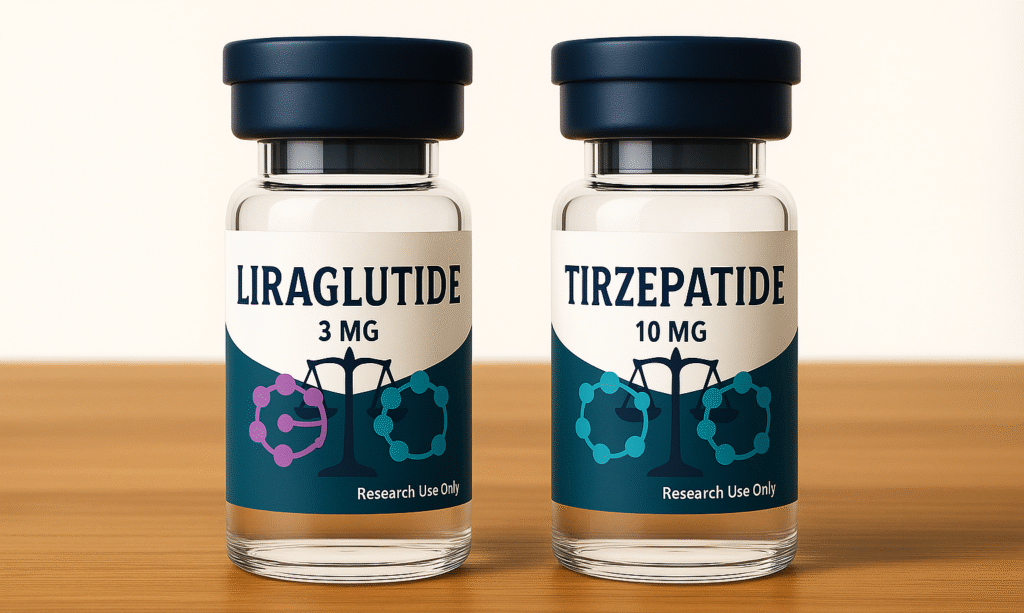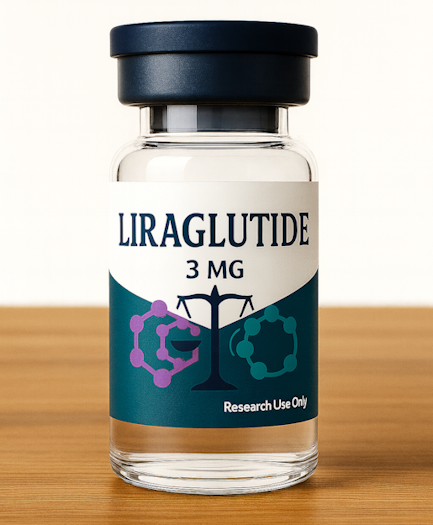
Comparing Liraglutide and Tirzepatide
Dive into detailed insights about Liraglutide and Tirzepatide, uncovering their unique actions, usage tips, and cost comparisons to empower your health decisions.
Choose the Best Option for You
Explore detailed comparisons of Liraglutide and Tirzepatide, including their effects, costs, and usage to find what suits your health goals.

Liraglutide
Discover how Liraglutide works to support weight management and blood sugar control, with expert-backed usage guidelines.
Mechanism of Action
Recommended Dosage
Cost and Availability
Side Effects
Patient Experiences

Tirzepatide
Learn about Tirzepatide’s innovative dual-action approach and how it differs from other peptides in treatment effectiveness.
Mechanism of Action
Recommended Dosage
Cost and Availability
Side Effects
Patient Experiences

Comprehensive Comparison
An in-depth look at both peptides, comparing benefits, risks, and practical considerations to guide your decision.
Mechanism of Action
Usage Guidelines
Pricing Overview
Potential Side Effects
User Feedback
Liraglutide Vs Tirzepatide: A Comprehensive Comparison for Weight Loss and Blood Sugar Control
The demand for effective weight loss medications has never been higher, as obesity, type 2 diabetes, and related health conditions continue to rise globally. Among the most widely discussed options today are Liraglutide vs Tirzepatide. These drugs are both injectable GLP-1 receptor agonists used for weight management and blood sugar control, but their mechanisms, dosing regimens, and clinical outcomes vary significantly.
Understanding the similarities and differences between these two treatments in the study population can offer valuable insights into how they work, their real-world effectiveness, and which patient profiles might benefit most.
Understanding the Medications: Liraglutide and Tirzepatide
As the medical community continues to explore effective treatment solutions for obesity management and type 2 diabetes, liraglutide vs tirzepatide stands out as a pivotal comparison. Both medications are injectable weight loss medications belonging to the GLP-1 receptor agonists class, but Tirzepatide introduces a significant pharmacological innovation by incorporating an additional mechanism of action. To fully understand their applications, it’s important to examine their origins, how they function, and the implications for long-term weight management and blood sugar control.
What Is Liraglutide?

Liraglutide, developed by Novo Nordisk, is a synthetic analog of human glucagon like peptide 1 (GLP-1). It was initially approved by the FDA in 2010 under the brand name Victoza for improving blood sugar levels in adults with type 2 diabetes. In 2014, a higher-dose formulation was approved as Saxenda for chronic weight management. As a GLP-1 receptor agonist, liraglutide works by mimicking the GLP-1 hormone naturally produced in the gut. This hormone plays a key role in regulating blood sugar, promoting insulin secretion, slowing gastric emptying, and reducing appetite, all of which contribute to weight loss and improved glycemic control.
Patients taking liraglutide administer it through subcutaneous injections once daily. Its pharmacokinetics allow for a steady release, maintaining stable drug levels in the bloodstream, but the daily injection requirement can be a challenge for some patients in terms of adherence. Still, liraglutide has shown substantial benefits in helping patients support weight loss, especially when combined with healthy habits, dietary changes, and physical activity.
What Is Tirzepatide?

Tirzepatide, marketed as Mounjaro and developed by Eli Lilly, represents a new class of medications referred to as dual GIP and GLP-1 receptor agonists. This means that, in addition to activating the GLP-1 receptor, it also stimulates the glucose dependent insulinotropic polypeptide (GIP) receptor. The addition of GIP agonism is believed to significantly impact insulin sensitivity and promote more profound weight reduction than GLP-1 action alone. Tirzepatide received FDA approval in 2022 for use in type 2 diabetes and is under further investigation for obesity treatment.
Unlike liraglutide, Tirzepatide is administered only once per week via subcutaneous injection, which offers a notable convenience factor. Many patients find the weekly dosing schedule more manageable, contributing to improved compliance and long-term success. Furthermore, Tirzepatide’s pharmacodynamics result in greater appetite suppression and enhanced blood sugar control, leading to more dramatic weight changes and weight loss results in both diabetic and non-diabetic populations.
The clinical impact of tirzepatide’s dual receptor action is substantial. In randomized controlled trials, patients treated with tirzepatide lost significantly more body weight than those treated with liraglutide. On average, significant weight loss reductions of 15% to 22.5% have been reported with tirzepatide, compared to 5% to 10% with liraglutide. These figures underscore why many patients and providers are increasingly viewing tirzepatide as a first-line agent for treating obesity, particularly in those with multiple health conditions like high blood pressure, high cholesterol, or sleep apnea.
Despite their shared goal of supporting weight loss and improving blood glucose, liraglutide and tirzepatide differ in more than just their pharmacology. The differences in treatment duration, monthly cost, insurance coverage, cost effectiveness and potential side effects also influence which medication may be the most appropriate for a given patient. For example, individuals with a history of medullary thyroid carcinoma, gallbladder problems, or kidney problems may need to avoid certain therapies or be monitored closely.
Ultimately, both liraglutide and tirzepatide represent significant advancements in the treatment of obesity and type 2 diabetes. Their growing use reflects the evolving understanding that weight loss medications can play a key role in managing health conditions associated with excess weight, particularly when pharmacotherapy is combined with lifestyle changes, nutrition, and behavioral support. As additional research findings emerge from ongoing systematic review studies, healthcare providers will have an even clearer picture of how to tailor treatment with these medications to individual needs.
Mechanism of Action and Clinical Impact
Both medications aim to assist in managing weight and improving blood sugar levels, but they achieve this in different ways. Liraglutide’s primary mechanism involves GLP-1 stimulation, which triggers insulin release, inhibits glucagon, and slows digestion. These effects help lower blood glucose and aid in weight loss by making users feel full longer.
Tirzepatide goes further by also activating the GIP pathway, which complements the effects of GLP-1 and enhances its metabolic benefits. This combination leads to greater reductions in body weight, improved cholesterol levels, and more robust control of high blood pressure and other health conditions related to obesity, including diabetic retinopathy. Studies suggest that Tirzepatide’s dual mechanism may also result in better preservation of beta cell function, a key aspect of long-term diabetes management.
Weight Loss Results and Average Reductions
When comparing liraglutide vs tirzepatide for effectiveness in weight reduction, multiple randomized controlled trials and meta analyses demonstrate a clear trend: patients taking Tirzepatide generally experience how much weight loss on average than those taking Liraglutide.
For instance, clinical studies show that patients on Liraglutide typically lose around 5% to 10% of their body weight, depending on the treatment duration and adherence to accompanying healthy habits. In contrast, Tirzepatide has been associated with significant weight loss, sometimes exceeding 20% of body weight, particularly in higher dosing protocols.
These findings reflect the enhanced appetite suppression and improved insulin secretion observed with Tirzepatide, which allows for more sustainable weight reduction in both diabetic and non-diabetic overweight patients.
Dosing Schedules and Treatment Compliance
Another area where the two drugs differ is in dosing schedules. Liraglutide requires daily subcutaneous injections, which can be a barrier to adherence for some patients. Side effects such as nausea and vomiting are common during the initial treatment duration, often leading to treatment discontinuation and potential to regain weight if not properly managed.
Tirzepatide’s once-weekly injection schedule offers a more convenient alternative, improving patient compliance and long-term outcomes. Its flexible titration process also allows for gradual dosage increases to minimize gastrointestinal adverse events, including delayed gastric emptying, diarrhea, and bloating.
This difference in dosing convenience, especially with once weekly semaglutide, has been cited in several studies as contributing to Tirzepatide’s greater cost effectiveness, particularly when factoring in improved health outcomes and reduced healthcare utilization due to better long-term results.
Managing Weight and Avoiding Weight Regain
One of the key challenges in sensitivity analysis of obesity management is sustaining progress after medication ends. Many patients experience weight regain after discontinuing treatment, which underscores the importance of lifestyle changes alongside pharmacological intervention.
Studies indicate that those on Liraglutide are more likely to regain weight within six to twelve months of stopping treatment. Tirzepatide, thanks to its dual-action mechanism and stronger appetite suppression, may offer more durable results, though weight changes can still occur if users fail to maintain healthy habits post-treatment.
In either case, long-term success depends on a multifaceted strategy that includes diet, exercise, behavioral therapy, and regular follow-up with a healthcare provider.
Efficacy Outcomes and Sensitivity Analysis
Recent data from systematic reviews and meta analyses show that research suggests Tirzepatide produces stronger efficacy outcomes than Liraglutide in most head-to-head comparisons. In sensitivity-adjusted models, Tirzepatide consistently demonstrated superior blood sugar control, greater bmi reduction, and more profound weight reduction.
One meta analysis of over 10,000 participants highlighted that Tirzepatide not only led to more weight loss, but also improved blood sugar levels more efficiently, with fewer adverse events and lower risk of treatment discontinuation.
Furthermore, the improvements in metabolic markers such as cholesterol levels, blood glucose, and blood pressure were more pronounced in the Tirzepatide groups. These results suggest that for patients seeking a comprehensive metabolic reset, Tirzepatide may be the more impactful choice.
Cost, Insurance Coverage, and Accessibility
When evaluating cost effectiveness, both short-term expenses and long-term value must be considered. Liraglutide’s monthly cost can be higher due to daily usage and limited insurance reimbursement, especially when prescribed for lower blood sugar levels rather than diabetes.
Tirzepatide, although newer and sometimes less widely covered, offers stronger outcomes per dollar spent, especially when considering its effects on health conditions like sleep apnea, high cholesterol, and high blood pressure. As more research findings confirm its benefits and more payers adopt it into their formularies, the insurance coverage landscape is expected to shift in Tirzepatide’s favor.
Both drugs should be discussed with a provider who can assess coverage, out-of-pocket costs, and co-pay assistance programs that might make either treatment more affordable.
Safety Profiles and Adverse Events
While both medications are considered safe and FDA approved, each carries a unique side effect profile. Common side effects for both include gastrointestinal issues such as nausea, constipation, and vomiting. In more severe cases, risks like gallbladder problems, pancreatitis, and kidney problems can arise, especially in patients with pre-existing conditions.
One area of concern for both drugs is the potential development of medullary thyroid carcinoma, although this remains a rare and theoretical risk based largely on animal studies. Another possible risk is worsening of diabetic retinopathy, particularly with rapid blood sugar improvement, which should be closely monitored.
Clinical studies also explored the drugs’ impact on obstructive sleep disorders, indicating that Tirzepatide may contribute to improved breathing patterns during sleep due to weight reduction, which in turn alleviates airway pressure.
Ultimately, the occurrence of side effects varies based on individual response, underlying health conditions, and concurrent use of other medications. Regular monitoring and dose adjustments can help minimize risks and maximize benefits.
Drug Class Differences and GLP-1 Receptor Impact
Though both medications fall into the GLP-1 receptor agonists category, Tirzepatide’s inclusion of GIP activation marks a significant departure from the typical drug class mechanisms. The enhanced action on both receptors provides deeper glucose regulation and appetite control, offering a more aggressive intervention for those with advanced metabolic disorders.
The GLP-1 receptor has long been known for its ability to lower blood sugar, increase satiety, and promote weight loss, but adding the glucose dependent insulinotropic polypeptide effect compounds these benefits by improving insulin response even further.
This distinction is critical when evaluating the long-term clinical impact of these drugs, particularly in patients struggling with excess weight and poorly controlled diabetes.
Real-World Use and Treatment Goals
Patients considering liraglutide vs tirzepatide should work closely with their medical team to clarify treatment goals. For some, the priority is rapid weight reduction to prepare for surgery or manage obstructive sleep apnea. For others, stable blood sugar control may be the primary objective, especially if managing multiple chronic conditions.
Liraglutide might be preferred for patients with established insurance coverage or those who prefer a drug with a longer safety history. Tirzepatide may be the better fit for individuals needing substantial bmi reduction and support weight loss with fewer injections.
In either case, the inclusion of healthy habits, nutritional counseling, and physical activity is essential to prevent weight regain and achieve lasting success.
Frequently Asked Questions
Q: Is it better to lose weight on Saxenda or Mounjaro?
Clinical data strongly suggests that Mounjaro (tirzepatide) leads to more weight loss than Saxenda (liraglutide). While both are GLP-1 receptor agonists, Mounjaro is a dual receptor agonist that targets both GLP-1 and glucose dependent insulinotropic polypeptide (GIP) receptors. This dual mechanism offers more powerful appetite suppression, enhanced blood sugar control, and significantly greater weight reduction.
In clinical trials, patients using Mounjaro lost an average of 15% to 22.5% of their body weight, while those on Saxenda typically achieved around 5% to 10% weight loss. This difference is substantial and has led many experts to conclude that Mounjaro provides more effective obesity management, especially for overweight patients with type 2 diabetes or other metabolic health conditions.
Q: What is better, tirzepatide or Saxenda?
Tirzepatide (Mounjaro) is generally considered the superior option when comparing tirzepatide vs Saxenda (liraglutide) for weight management, blood sugar control, and cost effectiveness. Mounjaro offers a once-weekly dosing schedule compared to Saxenda’s once-daily subcutaneous injections, which often improves patient adherence.
Moreover, research findings from multiple randomized controlled trials and meta analyses consistently show that tirzepatide leads to more weight loss, better glucose control, and improved health outcomes. However, Saxenda remains a trusted, FDA approved option with a longer safety record and broader insurance coverage for certain populations.
The choice between the two often comes down to individual needs, tolerance for side effects, and availability through insurance.
Q: Is Mounjaro better than liraglutide?
Yes, most recent systematic reviews and sensitivity analysis models indicate that Mounjaro (tirzepatide) is better than liraglutide for both weight loss and blood sugar management. Mounjaro’s dual action enhances insulin secretion, reduces appetite more effectively, and leads to higher weight loss results.
For example, in head-to-head studies, Mounjaro outperformed liraglutide in terms of bmi reduction, average weight loss, and improvements in cholesterol levels, blood glucose, and other clinical impact markers.
That said, Mounjaro may cause more gastrointestinal adverse events early in treatment, and it’s not suitable for everyone. This is especially true for those with a history of medullary thyroid carcinoma or kidney problems. Always consult a healthcare provider before initiating therapy.
Q: How long can you take liraglutide for weight loss?
You can take liraglutide for weight loss as long as it remains effective and is well tolerated, with many patients using it for long-term weight management under medical supervision. The drug has been studied in treatment durations of 56 weeks and longer, showing sustained benefits when combined with healthy habits, dietary changes, and physical activity.
However, patients should be regularly monitored for side effects, including delayed gastric emptying, gallbladder problems, and potential treatment discontinuation due to nausea or other adverse events. Some individuals may also experience weight regain if lifestyle changes are not maintained or the medication is discontinued abruptly.
Continued treatment is generally safe, but decisions on treatment goals and duration should always involve a healthcare provider to ensure optimal outcomes.
Final Thoughts: Which One Is Right for You?
Deciding between liraglutide vs tirzepatide requires weighing multiple factors, including desired weight loss results, existing health conditions, cost, injection preference, and how well the body tolerates the medication.
For those who are looking to lose weight quickly and sustainably, especially in the context of type 2 diabetes, Tirzepatide currently offers the most promising profile in terms of clinical impact, ease of use, and more weight lost. However, Liraglutide remains a proven option for many, especially when insurance coverage and long-term safety data are key concerns.
As the science continues to evolve and more data from randomized controlled trials and meta analyses become available, these therapies will likely become even more refined, offering patients more choices and better outcomes in the journey to improved health conditions and metabolic control.
Discover the Difference Between Liraglutide and Tirzepatide
Dive deep into the key distinctions, benefits, and usage guidelines of Liraglutide and Tirzepatide, helping you make informed decisions about these peptides.
- Detailed comparison of mechanisms of action
- Comprehensive guide on dosage and administration
- Insight into cost differences and affordability
- Up-to-date research and clinical trial summaries


In-Depth Look at Peptide Actions
Liraglutide vs Tirzepatide Explained
Discover detailed comparisons of costs, uses, and benefits to help you make informed decisions about these peptides.
Blog
Explore detailed comparisons, expert insights, and the latest updates on Liraglutide and Tirzepatide to deepen your understanding of these peptides.
